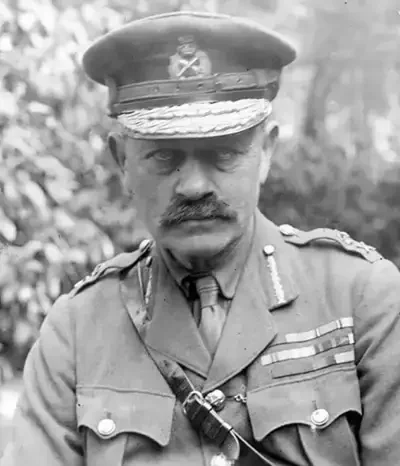- Military History
- Biographies
- Militarians Biographies
- Field Marshal Julian Hedworth George Byng
Field Marshal Julian Hedworth George Byng
One of the best British generals of World War I
Byng was born into a privileged life at Wrotham Park (Barnet) as the son of George Stevens Byng, Second Earl of Strafford, and was educated in Eton. He entered the militia, where he distinguished himself sufficiently to be posted into the elite Tenth Hussars in 1883.
The following year, he was dispatched with his unit to the Sudan to fight the forces of the Mahdi there. By 1889 he had attained the rank of captain and in 1894 he graduated from the Staff College. Promoted to major in 1898, they sent him to South Africa in the fall of 1899 to fight in the Second Boer War. His first task was to form a unit of local horse soldiers under Sir Redvers Henry Buller in Natal.
Leading these, Byng fought successfully at the Battle of the Tugela on February 17-18, 1900, and rode to the relief of Ladysmith on February 27. Gaining promotion to lieutenant colonel, Byng was given command of the South African Light Horse and was subsequently appointed to a position on Lord Kitchener's staff.
By the end of the war in 1902, Byng was colonel of the Tenth Hussars and two years later, he was named to head the cavalry school at Netheravon. Elevated to brigade command in 1907, they promoted him to major general in 1909 and the following year assigned to command the East Anglia Territorial Division. In 1910, they assigned him overall command of Britain's forces in Egypt.
Byng was recalled to Europe because of the outbreak of World War I, where he commanded the Third Cavalry Division at the First Battle of Ypres from October 30 to November 24, 1914. He commanded the Cavalry Corps on the western front until August 1915, when he headed the IX Corps at Suvla Bay during the ill-fated Gallipoli campaign (August 1915 - January 1916). As commander of the Canadian Corps in Flanders, he was instrumental in the capture of Vimy Ridge on April 9, 1917, the opening day of the Arras Offensive.
Added to this triumph was his excellent performance as general and commander of Third Army a post to which he was appointed in June and from which he planned and executed the Cambrai Offensive during November 20 to December 3. Although an officer of the old school, Byng used the Cambrai Offensive to test and show the effectiveness of the latest technology - the tank. However, like most campaigns throughout World War I, the Cambrai operation won no significant breakthrough.
Byng enjoyed greater success in resisting the German "Operation Michael" offensive along the Somme during March 21 to April 5, 1918; and he was in the forefront of the final Allied offensives in Flanders from August until November of the same year.
Following the Armistice, they promoted Byng to baron in 1919 and appointed him as governor general of Canada, where he served to great popular acclaim from 1921 to 1926. Made a viscount in 1926, they appointed him as the Commissioner of London's Metropolitan Police.
Byng died suddenly of an abdominal blockage at Thorpe Hall on 6 June 1935 and was buried at the 11th Century Parish Church of St. Leonard in Beaumont-cum-Moze (Essex, England).
Field Marshal Julian Hedworth George Byng - Quick Facts
- 10th Royal Hussars (British Army)
- 1st Cavalry Brigade (British Army)
- 2nd Cavalry Brigade (British Army)
- British Third Army
- Canadian Corps
- Egypt Command (British Army)
- IX Corps (British Army)
- South African Light Horse (British Army)
- XVII Corps (British Army)
- Mahdist War (1881-1899)
- Second Boer War (11 October 1899 – 31 May 1902)
- WWI (1914-1918)
- {{#owner}}
- {{#url}} {{#avatarSrc}}
{{name}} {{/url}} {{^url}} {{#avatar}} {{& avatar}} {{/avatar}} {{name}} {{/url}} - {{/owner}} {{#created}}
- {{created}} {{/created}}
























